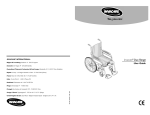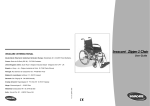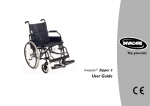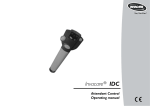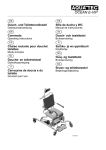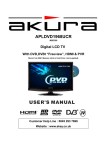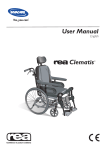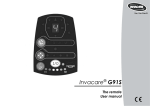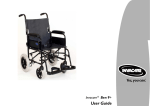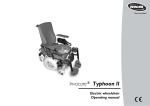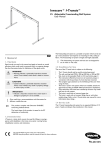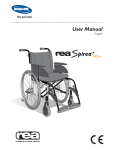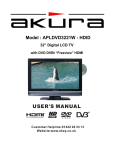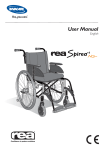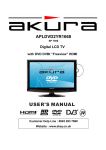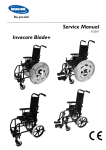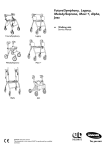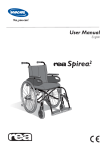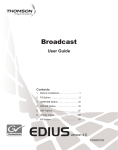Download User Manual
Transcript
Invacare Blade + R User Guide Introduction Thank you for choosing a Blade + manual wheelchair- we are certain that you will be delighted with it. Just to make doubly sure you really gain the full benefits from your remarkable new INVACARE wheelchair and to ensure many years of trouble free performance, this manual gives you essential information concerning Safety, Handling and Operation, together with some helpful tips. Please read it carefully before trying out your new Blade +, so that you may truly enjoy your new independence. We recommend to have your wheelchair inspected and serviced by an authorised INVACARE dealer at least once a year. It is in your best interests, not only to ensure your personal safety, but also the continued high performance and long service life of your chair. Whenever you need special advice and assistance, or if there is any problem with your chair, do not hesitate to contact the local INVACARE dealer. He is just a phone call away and has all the equipment and knowhow required to provide you with expert professional service. Note for wheelchair users INVACARE provides a wide range of wheelchairs to meet the requirements of users. However, the decision on the type of model to be prescribed rests exclusively with qualified advisors. INVACARE or its appointed representative shall not be held responsible if a wheelchair is used that is unsuitable for the user s level of disability, if the wheelchair itself is incorrectly used or if a problem arises due to poor maintenance. The information set out in this manual may be modified without prior notice. This manual contains copyright information. All rights are reserved. No part of this document may be photocopied or reproduced without prior written agreement from INVACARE or its appointed representative. This manual gives details of all the options of the Blade + range of wheelchairs. It describes the options, operation and adjustments that may be required. However, your INVACARE retailer will be able to give you further information and demonstrations. SAFETY NOTICE PLEASE ENSURE THE WHEELCHAIR IS FULLY OPENED AND THE SEAT RAILS ARE LOCATED IN THE SEAT SADDLES BEFORE SITTING DOWN 1 Table of contents Page Note for wheelchair users. . . . . . . . . . . . . . . . . . . . . . . . . . . . . . 1 Table of contents. . . . . . . . . . . . . . . . . . . . . . . . . . . . . . . . . . . . . 2 1. Safety and operating limits . . . . . . . . . . . . . . . . . . . . . . . . . . . 4 1.1 Weight limit . . . . . . . . . . . . . . . . . . . . . . . . . . . . . . . . . . . . . 4 1.2 Reaching for an object from a wheelchair . . . . . . . . . . . . . . . 4 1.3 Transferring to other seats . . . . . . . . . . . . . . . . . . . . . . . . . . 7 1.4 Tilting the wheelchair . . . . . . . . . . . . . . . . . . . . . . . . . . . . . . 9 1.5 Kerbs . . . . . . . . . . . . . . . . . . . . . . . . . . . . . . . . . . . . . . . . . 10 1.6 Stairs . . . . . . . . . . . . . . . . . . . . . . . . . . . . . . . . . . . . . . . . . 11 1.7 Upward and downward slopes . . . . . . . . . . . . . . . . . . . . . . 12 2. Use. . . . . . . . . . . . . . . . . . . . . . . . . . . . . . . . . . . . . . . . . . . . . 13 2.1 Folding and unfolding the wheelchair . . . . . . . . . . . . . . . . . 13 2.2 Propelling the wheelchair . . . . . . . . . . . . . . . . . . . . . . . . . . 14 3. Summary of safety instructions . . . . . . . . . . . . . . . . . . . . . . 15 4. General description . . . . . . . . . . . . . . . . . . . . . . . . . . . . . . . . 16 5. Backrests. . . . . . . . . . . . . . . . . . . . . . . . . . . . . . . . . . . . . . . . 18 6. Seat . . . . . . . . . . . . . . . . . . . . . . . . . . . . . . . . . . . . . . . . . . . . 18 7. The various types of armrest . . . . . . . . . . . . . . . . . . . . . . . . 18 2 Table of contents cont. 8. Folding chassis . . . . . . . . . . . . . . . . . . . . . . . . . . . . . . . . . .19 9. Rear wheels . . . . . . . . . . . . . . . . . . . . . . . . . . . . . . . . . . . . .19 10. Castors . . . . . . . . . . . . . . . . . . . . . . . . . . . . . . . . . . . . . . . .21 11. Brakes . . . . . . . . . . . . . . . . . . . . . . . . . . . . . . . . . . . . . . .21 12. Footrests . . . . . . . . . . . . . . . . . . . . . . . . . . . . . . . . . . . . . .22 13. Backrest Extension . . . . . . . . . . . . . . . . . . . . . . . . . . . . . .23 14. Rear Anti-tippers . . . . . . . . . . . . . . . . . . . . . . . . . . . . . . . .24 15. Transit kit . . . . . . . . . . . . . . . . . . . . . . . . . . . . . . . . . . . . . .24 16. Safety belt . . . . . . . . . . . . . . . . . . . . . . . . . . . . . . . . . . . . .25 17. Spoke guards . . . . . . . . . . . . . . . . . . . . . . . . . . . . . . . . . . .25 18. Tipping Lever . . . . . . . . . . . . . . . . . . . . . . . . . . . . . . . . . . .25 19. Adjusting Recliner Backrests . . . . . . . . . . . . . . . . . . . . . .26 20. Hub Brakes . . . . . . . . . . . . . . . . . . . . . . . . . . . . . . . . . . . .26 21. Routine Checks and Maintenance . . . . . . . . . . . . . . . . . .27 22. Transport . . . . . . . . . . . . . . . . . . . . . . . . . . . . . . . . . . . . . .28 23. Warranty . . . . . . . . . . . . . . . . . . . . . . . . . . . . . . . . . . . . . . .30 24. Storage . . . . . . . . . . . . . . . . . . . . . . . . . . . . . . . . . . . . . . . .30 25. Cleaning . . . . . . . . . . . . . . . . . . . . . . . . . . . . . . . . . . . . . . .30 3 1 - Safety and operating limits Stability and equilibrium To ensure that the wheelchair remains stable and is manipulated correctly, you must always maintain good equilibrium. Many actions cause the user of a wheelchair to reach out, lean over or move about within the wheelchair and outside it. These actions will change your centre of gravity and weight distribution of the wheelchair. Your wheelchair has been designed to remain stable for normal everyday use if it is used correctly taking the precautions recommended in this manual. 1.1 - Weight limit The maximum user weight limit for the Blade + is 89kg. This weight includes accessories such as a compact oxygen cylinder or other equipment required by the user. However, the wheelchair users’ degree of activity is important. For example, an active user weighing 75kg may subject the wheelchair to more stress than a user weighing 115kg. We recommend very active wheelchair users to choose an appropriate design of wheelchair. Your INVACARE approved distributor will advise you on the best model. 1.2 - Reaching for an object from a wheelchair The limitations on reaching out from a wheelchair shown in figure 1 have been produced using a representative sample of wheelchair users. Only the arms should extend beyond the seat of the wheelchair. For safety reasons, the body and head should remain within the wheelbase. 4 1 2 Position the castors to give the longest possible wheel-base. (Figure 2) Lock the manual brakes on the rear wheels. Leaning forwards (Figures 3, 4 and 5) 3 Move the wheelchair as close as possible to the object you wish to reach. Only reach out to take what is within arms length in normal sitting position. 4 5 5 Leaning backwards (Figures 6 and 7) Move the wheelchair as close as possible to the object you wish to reach. Only lean back for objects that are within arms length in normal sitting position. 6 7 Leaning to one side (Figure 8) This is the most dangerous manoeuvre as it is easy to tip sideways. To move up to the object and lean over, you must use the castors as a means of keeping the wheelchair stable and balanced. (Figure 2) For your safety, it is essential to be in the correct position. Do not try to pick something up from the floor if this would upset your balance. 6 8 1.3 - Transferring to other seats 9 It is possible to move from and to a manually propelled chair if the following guidelines are followed. INVACARE does not recommend any particular method for transferring: this is the responsibility of a medical advisor who should consider your level of disability and type of wheelchair. 10 When transferring, either to get out of or return to your wheelchair, make sure: - That the gap between the two seats is as small as possible. (Figures 9 and 10) 11 - That the manual brakes on the rear wheels are on to prevent the wheels moving. (Figure 11) 12 Turn both castors towards the seat to which you wish to move. Lift up the footplates. Do not stand on the footplates. 7 13 If possible, fold back the footrest supports to the side to clear the way. (Figure 13) 14 If possible, remove the armrests on the side between the wheelchair and the other seat. (Figure 14) 15 NB Never stand up on the footplates. (Figure 15) 8 1.4 - Tilting (balancing on the rear wheels) Tilting without help from a third person Wheelchairs in the INVACARE range have been designed for use by those who have mastered the technique of balancing on the rear wheels without help from a third person. However, you should never exceed the limitations of the wheelchair. Repeated shock on the castors caused by tipping the wheelchair up yourself may affect the rigidity or settings of your wheelchair. If your wheelchair is fitted with accessories, these may affect the methods used for balancing on the rear wheels. When you wish to learn a new technique, consult an experienced person for advice in using your type of wheelchair. Tilting with assistance from a third person The user should be sitting correctly and firmly in the chair or if unable to support themselves, should be strapped in position to prevent him/her falling out of the chair. If a wheelchair user needs assistance in tilting the chair, the assistant must know how to use their body correctly. Keep your back straight and bend at the knee to tilt the wheelchair. Never exert too much force. The medical team in charge of the user will advise you in the methods best suited to your morphology. The INVACARE approved distributor will provide you with information on the risks of using the wheelchair incorrectly if the wheelchair has removable parts such as armrests or leg rests. These must NEVER be used as aids when lifting as they may inadvertently become detached and cause injury. To tilt the wheelchair (Figure 16), a third person should grip the handles firmly. 16 Warn the user of the wheelchair before tilting it and remind him/her to lean backwards. Check that the user’s feet and hands are clear of all the wheels. Place a foot on the foot step tube and push smoothly until the wheelchair is at the point of equilibrium. At this stage, the helper will feel a difference in weight distribution which usually occurs at an angle of about 30°. Turn the wheelchair in the direction 9 Lower the front of the wheelchair smoothly, holding the handles firmly. Use your weight on the foot step tube to act as a counterweight. Do not lower the wheelchair suddenly down the last few centimetres before returning to the normal position as this may hurt the user. 1.5 - Kerbs or obstacles 30 to 50mm high Method 1 - Negotiating the obstacle forwards (Figure 17) The helper should tilt the wheelchair until the castors have passed over the kerb. Move the wheelchair forwards and lower the castors gently onto the pavement. Push the wheelchair until the rear wheels touch the kerb. Lift and push until the rear wheels have mounted the kerb. Do not lift by the handles on the backrest. 17 Method 2 (Figure 18) The helper should stand on the 18 pavement and turn the wheelchair until the rear wheels are against the kerb. Tilt the wheelchair backwards to the point of equilibrium and, in a continuous movement, pull the wheelchair until the rear wheels mount the kerb and pass onto the pavement. Do not lower the castors to the ground until you have pulled the backrest of the wheelchair sufficiently far to clear the kerb. NB: Folding backs should always be checked to ensure they are engaged. 10 1.6 - Steps, stairs or obstacles over 50 mm high We recommend that you take very great care when taking a wheelchair up or down stairs. Two people are required for this. ADVICE TO THIRD PERSONS Make sure that you get hold of fixed, non-removable parts only. Use the following procedure for going up stairs: (Figure 19) Tilt the wheelchair to its point of equilibrium. One helper (at the back) holds the wheelchair up against the first step, gripping the handles firmly to lift. 19 The second helper, holding firmly a fixed part of the front frame, lifts the wheelchair above the stairs and holds it while the first helper places one foot on the following step and repeats the operation. The wheelchair must not be lowered until the last step has been negotiated and until the chair is clear of the stairs. Escalators Do not use an escalator when moving a wheelchair from one floor to another. This might cause serious injury. 11 1.7 - Upward and downward slopes (operating limits) Do not attempt to go up or down slopes greater than 9% without assistance. (Figure 20) 20 Always go straight up and down slopes otherwise the wheelchair might overturn. (Figure 21) 21 Upward slopes Lean the upper part of the body forward and push the chair forward with short quick thrusts on the handrims to maintain speed and control direction. If you wish to take a rest, apply both brakes when stopping. (Figure 22) NB: The use of Anti Tippers is recommended in traversing upward slopes. 12 22 Downward slopes 23 Lean backwards carefully and allow the handrims to slide through your hands. Be ready to react at any moment to check the speed and direction by keeping in close contact with the handrims. The manual brakes should not be used to slow you down. (Figure 23) If you are going up or down a slope avoid turning sharply and never try to go up or down diagonally. 2-Use 2.1 - Folding and unfolding the wheelchair Wheelchair with fabric upholstery. To fold Lift the footplates. Release the backrest tensioner if necessary. Using both hands, take the centre of the seat fabric at the front and back edges and raise it. (Figure 24) Or, tilt the wheelchair to one side and close it using the handles on the back rest or the armrests. (Figure 25) 24 25 13 To unfold 26 (Figure 26) Unfold the wheelchair by taking hold of the armrest or the side of the chair nearest to you, tip the chair sideways (lifting the rear wheel and the castor from the ground) and press on the tube supporting the seat upholstery until it is fully down. The seat upholstery should be fully open. NB To avoid injury, keep hands and fingers away from moving parts (armrests, folding frame, footrest supports or leg rests, etc). 2.2 - Propelling the wheelchair The wheels of your wheelchair are fitted with handrims (Figure 27) and qualified personnel will be able to advise you on the most appropriate way of propelling yourself. Various accessories may be fitted to improve the grip (plastic coatings, studs). Lean the upper part of the body forward and push the chair forward with short quick thrusts on the handrims to maintain speed and 27 control direction. Be ready to react at any moment to check the speed and direction by keeping in close contact with the hand-rims. 14 3 - Summary of instructions for improved safety - Do not try to reach objects if you have to move forward on the seat. - Do not try to reach objects on the ground if you have to lean down beyond the safety limits. - Do not lean too far back to reach objects behind you: you may tip over. - Do not move your weight, or your sitting position in the direction in which you wish to go: you may tip over. - Always apply both manual brakes before trying to get out of or back into the wheelchair. - The manual brakes are not designed for slowing you down. - Do not try to stop a moving wheelchair using the manual brakes. - Do not tilt the wheelchair without assistance from a third person when negotiating obstacles more than 30 mm high. - Do not use an escalator for moving a wheelchair from one floor to another (this may cause serious injury). - Do not use your wheelchair if the tyres are not inflated to the correct pressure shown on the side. - Do not over-inflate the tyres. Failure to comply with these instructions may cause the tyre to burst and cause bodily injury. - Carry out the regular checks recommended in this guide and by your INVACARE approved retailer. - Use your wheelchair with respect for other people. - Do not use your wheelchair as a transport seat in a vehicle. Unless it is not practical for the user to be transferred (Refer to section 23 - Transport). 15 4 - Description Each wheelchair is specially designed to meet the requirements of its user. This manual describes how to adjust the chairs in this range, enabling you to find out how to adjust the wheelchair to suit your needs. General description Your wheelchair has a number of main parts which will be mentioned throughout this manual. These parts are described below. Support is provided by the backrest, seat and armrests. The folding chassis comprises of the side frames and folding cross brace. This is the essential supporting framework of the wheelchair on which all the other parts are mounted. The rear wheel comprises of the wheel, axle and handrim. The rear wheels provide contact with the ground and are driven by turning the handrims. The front castors comprise of the fork and wheels. The front wheels provide contact with the ground and the rotating forks steer the chair. Manual brake The manual brake is used to park the wheelchair. Swing away footrest support and leg rest These are connected to the chassis and can be swung away to make transfer easier to and from the wheelchair. The footplate assembly comprises of the adjustable tube and foot plate. These support your feet. The heel support strap or calf support strap These two straps support your feet or legs in the best position. These parts are illustrated on the following diagram. 16 Backrest Armrest Seat Footplate Rear Wheel Swingaway Footrest Support Front Castor Manual Brake 17 5 - Backrest Photographs 1 and 2 The backrest can be folded at the middle by means of a locking mechanism and can be operated by either the user or an attendant. - Use: To fold the 2 1 backrest, pull both black plastic locking levers (A) downwards and fold the top part of the backrest to the back and then down. Carry A out these operations in the reverse order to return the backrest to its normal position, making sure that the locking mechanisms (A) are secure. 6 - Seat Photograph 3 - Your seat upholstery is screwed onto the seat tubes of the folding cross brace. - Adjustment: This model requires no adjustment. Just check regularly that the screws (A) are tight. If the washers (B) are loose, these screws should be tightened. If the problem continues, contact your INVACARE retailer and ask him to change the mounting for safety reasons. 3 A B Seat cushion The seat cushion is placed on the upholstery and must be removed when folding the chair. 7 - Removable, swing-away adjustable height armrest Photograph 4 The armrests can be removed for easier storage and allow sideways transfer from the chair. They can also be adjusted in height to suit the individuals preference. 18 To adjust the height, the armrest lever is lifted up which allows the armrest to slide up and down, within the armrest block. When the desired height has been achieved, lower the armrest lever and push down/pull up the armrest until the armrest drops into place. To make sure that this has happened try to pull up/push down the armrest, if it is located the armrest should be “locked in”, and the lever should be in its down position. 4 Notches Armrest Armrest Lever Armrest Block PUSH 8 - Chassis Side Frames - The side frames provide the mounting points for the rear wheels and the castors. - Adjustment: No adjustment is possible on this series of wheelchair. Folding cross brace - The folding cross brace has two members which enable the wheelchair to be folded. - Adjustment: No adjustment is required. To fold or unfold your wheelchair, refer to this user and safety manual. 9 - Rear wheels Photograph 5 Wheels - The rear wheels are positioned on rear wheel mounting blocks which determine the rearward stability. This position should only be adjusted by a qualified technician on the advise of a qualified advisor. The rear wheels have a diameter of either 315mm, 500mm, or 550mm. They are equipped with spokes and handrims. They can have pneumatic tyres or solid tyres and can be connected to the side frame by means of a fixed axle or a quick release axle. 19 Tyre pressure 5 The pressure is shown on the tyre and must never be exceeded. Remember that the tyre pressure on both wheels should be the same to ensure perfect steering. In case of a puncture, the tyre has to be removed from the rim. Press the valve to let all the remaining air out of the inner tube. Pull the tyre off the rim. Repair or replace the inner tube. Put the tyre back on the rim. Inflate the tyre to the required pressure. - NB: It may be necessary to use one or two tyre removal tools (not supplied). Handrims - The handrims are used by the user to drive the wheelchair. - NB: As the handrims are in contact with your hands, make sure that they are not damaged and that the surface has no parts which might cause injury to the hands. - Adjustment: No adjustment is required for the handrims. Axles Photographs 6 and 7 - The axles link the back wheels to the chassis. They are fixed or quick releasing. - Quick release wheels Removal: Push on the quick release button head with your finger and pull the wheel towards the outside of the chair. - Assembly: button head axle though secured (no 20 6 Push on the quick release with your finger and locate the axle bush, making sure that the axles are axial movement). - Fixed wheels No adjusment is required, however, check on a weekly basis that the axle / nut are secure. 7 10 - Castors Front wheels - The front wheels have a diameter of 125mm. Available in solid puncture-proof tyres only. No adjustment is necessary for the front wheels. 8 Forks Photograph 8 - The fork connects the chassis and the wheel. - Adjustment: The forks do not require adjustment. Check that the fork rotates freely. 11 - Manual brakes Photograph 9 Brakes - The manual brakes are used to immobilise the wheelchair in a stationary position. They are not intended for slowing down and should not be used when the wheelchair is moving. They should be applied together. A 9 - Use: The brakes are operated by moving the brake handle (A) towards the front of the wheelchair. When the brakes are applied, the wheelchair should resist movement. - Adjustment: It may be necessary to adjust the brakes after repairing a puncture or because of wear on the pneumatic or solid tyre. Slacken clamp screws and adjust the brake assembly to achieve adequate braking. Tighten the clamp screws firmly after adjustment. NB: The brakes are fitted in pairs to the wheelchair. When adjusting or 21 removing, remember that there is one brake for the right hand side and another for the left hand side. Brake extension - The brakes may be equipped with a handle extension to assist attendants/user who have insufficient strength or difficulty in reaching the standard brake handles. 12 - Footrest Photograph 10 and 11 Swing away footrest supports The footrest supports can be swung away to the outside/rear of the chair to free the front of the wheelchair making it easier for the user to transfer to another seat. They can also be removed. 10 - Use: To swing the support to the outside, press the release mechanism lever. Rotate the support carefully to the outside of the wheelchair. To return the support, repeat the operations in the reverse order. Check that the release mechanism has automatically locked. 11 To remove the support, swing the assembly away from the chair, release the spring mechanism and lift the support away from the chair. - Adjustment: Loosen the two screws, adjust to the required height and re-tighten screws. NB: The footrest supports are fitted in pairs to the wheelchair. When adjusting or removing, remember that there is one support for the right hand side and another for the left hand side. Footplate Assemblies Photograph 12 22 Independent footplates for footrest supports - The footplate assemblies comprise of an adjustment tube and footplate and are intended solely as a foot support when you are sitting in the wheelchair and should not be used for standing. Each footplate assembly can be adjusted in height. The footplates can be pivoted to an upright position to aid front transfers. 12 - Adjusting the footrests on the supports: Release the nut, position the footplate assembly at the required height in the footrest support tube, tighten the nut to secure. 13 - Backrest Extension Photograph 13 The backrest extension has two uprights (B) and a backrest extension upholstery. The locating pegs should only be fitted to the push handles of the backrest by a qualified technician. When refitting, make sure that it is firmly fixed onto the locations fitted to the backrest tubes. Raise the head rest assembly to 13 remove it from the tubes of the recliner backrest. - Adjustment: No adjustment is required for this extension. However, it can be removed for transport. FITTING INSTRUCTIONS BACKREST EXTENSION FOR VEHICLE TRANSPORT B When transporting the chair the backrest extension must be secured to the push handles. Using a M5 x 30mm Hex Hd screw and location ring (See photo below) Slide the location ring inside the slot on the extension tube, and then feed the Hex Hd screw through the tube and location ring and firmly secure to the push handle. 23 14 - Rear Anti-tippers Photograph 14 The anti-tippers help prevent you from tipping over when the rear wheels are incorrectly positioned, or when the user or attendant mishandles the 14 A wheelchair. - Use: The anti-tippers fit into the rear tubes of the side frames (A). Fit the anti-tippers into the side frame rear tube, until the button springs are positioned in the holes of the rear tube (A). Carry out these A operations in the reverse order to remove. You can leave the anti-tip castors on the wheelchair even if you do not wish to use them. Just depress the button spring and rotate the entire anti-tipper unit a half turn (180°). DO NOT twist or turn the Anti-Tipper when withdrawing it from the frame. NB: The anti-tippers are not to be used as tipping levers. 15 - Transit kit Photographs 15 and 16 15 The transit kit includes a manual brake for operation by an attendant. NB: This brake is different to the self propelled version. Also included is a choice of either pneumatic or solid tyred wheels. - Adjustment: It may be necessary to adjust the brakes after repairing a puncture or because of wear on the pneumatic or solid tyre. Slacken clamp screws (B) and adjust the brake assembly to achieve adequate braking. Tighten the clamp screws (B) firmly after adjustment. 24 B 16 The pressure of the pneumatic tyres should be checked before use of the wheelchair. The pressure is shown on the tyre and must never be exceeded. In case of a puncture, the tyre may have to be removed from the rim. Press the valve to let all the remaining air out of the inner tube. Remove the tyre off the rim. Repair or replace the inner tube. Put the tyre back on the rim. Inflate the tyre to the required pressure. NB: It may be necessary to use one or two tyre removal tools (not supplied). The tyre pressure on both wheels should be the same. 16 - Safety Belt The strap can be adjusted by the user with a buckle system. A qualified advisor must show you how to position the strap according to your needs. 17 - Spoke guards The spoke guards must be assembled by a qualified technician. The spoke guards do not require any adjustment. 18 - Tipping Levers Photograph 17 The tipping lever can only be used by an attendant and it is designed to assist tipping the chair rearwards when obstacles are encountered, such as pathway or kerbs. 17 A The tipping lever tubes are fixed into the rear tubes of both side frames (A). B Fit the tipping lever into the side frame rear tube, until the button springs (B) are positioned in the holes of the rear tube (A). - Use: The attendant, whilst pulling the wheelchair push handles must press on the tipping levers with either foot, in order to raise the front of the wheelchair to the required height. 25 19 - Adjusting Recliner Backrests Gas Spring Type CAUTION: It is recommended that this operation be performed only by the attendant. Always make sure that the backrest is locked in place to ensure perfect safety for the user. Keep fingers away from moving parts (levers, cylinders, mechanisms, etc.) to prevent injuries! 1. Grip the push handles with both handles 2. Pull the triggers and raise or lower the back to the desired position, supporting the backrest by means of the push handles at all times during adjustment. Release triggers 20 - Hub Brakes Besides the functions provided by manual brakes, the optional hub brakes provide slow down (for example, on a slope) and improve safety because they are still efficient when you have a flat tyre! To slow down gradually pull the lever upwards. To lock the brake in parking position, with the lever tightened, push the lock to engage it in the notches of the brake handle;then pull the lock up to unlock. To adjust braking:turn the screw counterclockwise to increase braking force and turn clockwise to reduce it. The specific adjustments of hub brakes must always be performed by your Dealer. Always operate the two brakes simultaneously and do not take slopes exceeding 5% to ensure perfect control of the wheelchair steering! Always mount the hub brake attachment in backward position 26 21 - Routine checks and maintenance Checking performance As a user, you are the first to notice that your wheelchair is not operating properly. The following table shows some readily identified symptoms and gives the preliminary checks to be carried out. As a general rule, the parts subject to wear should be monitored and changed most often: tyres on the rear wheels, front castor wheels, brake pads, upholstery. The wheelchair The wheelchair The wheelchair drags drags turns or to the right to the left moves slowly X X X X X Creaks and clicking Play in the chair X X X The castors wobble Checks Check that the tyre pressure is correct and even X X X X Check that nuts, bolts and screws are tight Check that the angle of the front forks is correct X Check that the castors are both in contact with ground at the same time If the symptoms persist when the tyre pressure has been corrected and the nuts, bolts and screws have been tightened, consult your approved INVACARE distributor. Checking the general condition For maintenance operations, consult your distributor who has all the necessary information. Twice a year, ask your distributor to inspect your wheelchair thoroughly and carry out in depth maintenance. Regular maintenance allows defective or worn parts to be identified and improves the normal operation of your wheelchair. The following table shows what to check when the wheelchair is delivered, each week, each month and at 6 monthly intervals. 27 X 6 Monthly Service . . . . . . .X . . . . . . .X Monthly inspection/adjustment Weekly inspection/adjustment 1. General The wheelchair unfolds and folds easily . . . . . . . . . . . . . . . . . . . . . . . . . . . . . The wheelchair moves in a straight line (no resistance or drag) . . . . . . . . . . . . 2. Manual brakes The manual brakes do not touch the tyres when moving . . . . . . . . . . . . . . . . . The manual brakes are easy to operate . . . . . . . . . . . . . . . . . . . . . . . . . . . . . The articulations are not worn and do not show signs of play . . . . . . . . . . . . . . 3. Cross bars Examine them to check that they are not worn or bent . . . . . . . . . . . . . . . . . . . 4. Clothing protectors / armrest upholstery Check that all fixings are in position and tightened . . . . . . . . . . . . . . . . . . . . . 5. Armrests Firmly attached but easy to remove . . . . . . . . . . . . . . . . . . . . . . . . . . . . . . . . 6. Arm pads Check that the padding is in good condition . . . . . . . . . . . . . . . . . . . . . . . . . . 7. Seat and backrest upholstery Check that it is in good condition . . . . . . . . . . . . . . . . . . . . . . . . . . . . . . . . . . 8. 22" and 24" wheels Wheel nut and sealed bearings correctly tightened . . . . . . . . . . . . . . . . . . . . . No excessive lateral movement or binding when they are lifted from the ground and turned, quick release axles correctly locked . . . . . . . . . . . . . . . . . . . . . . . 9. Handrims Check for rough patches . . . . . . . . . . . . . . . . . . . . . . . . . . . . . . . . . . . . . . . . 10. Spokes Inspect the spokes in case any are bent, broken or slack . . . . . . . . . . . . . . . . 11. 6" or 8" castors Check the axle to ensure that it is correctly tightened, by turning the castor The castor should stop gradually . . . . . . . . . . . . . . . . . . . . . . . . . . . . . . . . . . 12. Fork / Fork tube Check that all the fittings are in place . . . . . . . . . . . . . . . . . . . . . . . . . . . . . . . 13. Pneumatic and solid tyres If the wheelchair has pneumatic tyres, check that they are correctly inflated (the pressure is shown on the sidewall) . . . . . . . . . . . . . . . . . . . . . . . . . . . . . If the wheelchair has solid tyres, check the running surface . . . . . . . . . . . . . . . On delivery Checks to be made X . . . . . . .X . . . . . . .X . . . . . . .X X X X . . . . . . .X X . . . . . . .X X . . . . . . .X X . . . . . . .X . . . . . . .X X X . . . . . . .X X X . . . . . . .X X . . . . . . .X X . . . . . . .X X . . . . . . .X X . . . . . . .X X . . . . . . .X . . . . . . .X X X 22 - Transport Invacare always advises that a wheelchair secured in a vehicle will not provide the equivalent level of safety and security of vehicle seating systems and recommends transfer to the vehicle seating, but also recognises that it is not always practical for the user to be transferred. In those cases where it is considered that the user must be transported whilst within the wheelchair, then the following advice should be followed. 28 1. Seek confirmation from the Transporter that the vehicle is suitably designed and equipped to transport a passenger seated in a wheelchair. NB: The wheelchair user safety during transportation largely depends upon the diligence of the person securing the tie downs and passenger restraints. 2. Any part of the wheelchair (accessories etc.) that can be easily detached should be removed and stored in the vehicle luggage hold during transportation. 3. The wheelchair should always be transported in a forward facing direction. Rearward facing is only acceptable if the occupant’s head and back can be supported by a suitable bulkhead. 4. If the wheelchair is equipped with a headrest, it should always be used during transportation. 5 Invacare recommend that the wheelchair be secured by 4-Point webbing tie down systems as manufactured by Unwin Safety Systems or Koller Safety Restraint Engineers. 6 When attaching tie downs to the wheelchair it is imperative these are fixed onto the MAINFRAME of the wheelchair and not onto any attachments or accessories ( wheels, handrims, castors, footrests, anti tipping levers etc.) 7. The tie downs should be secured, as close as possible, at an angle of 45 degrees to ensure maximum effectiveness of the restraint in all directions. 8. The occupant should be restrained independently of the wheelchair by a suitably Approved passenger safety belt or harness. Pelvic restraint or lap belts supplied with the wheelchair may be used in addition to but never as a substitute for Approved passenger restraints. 29 23 - Warranty This is to certify that your Blade + wheelchair is warranted by Invacare, for a period of 2 years. This warranty is subject to the following conditions: 1. 2. 3. 4. 5. 6. Only Invacare wheelchairs purchased at full price are warranted against defective workmanship and materials. If a defect or fault is discovered the supplier from whom the appliance was purchased/obtained should be notified immediately. The manufacturer will not accept responsibility for damage caused by misuse or the non-observance of the intructions set out in the User Manual. During the period of the warranty, any parts that have become defective due to faulty workmanship or materials, will be renewed or repaired free of charge by the Invacare supplier. The warranty will be forfeited should any unauthorised alteration be made to the equipment. The purchaser s statutory rights under the Consumer Protection Act are not affected. Limitation of liability This warranty does not extend to the consequential costs resulting from fault clearance, in particular freight and travel costs, loss of earnings, expenses, etc. Invacare shall not be liable for: - natural wear and tear - unappropriate or incorrect use - defective assembly or setting-up by the purchaser or third parties - defective or negelectful treatment - use of unsuitable spares 24 - Storage When you will not be using your wheelchair for a prolonged period, the following precautions will help to keep it in perfect condition. Store the wheelchair in a clean, dry place. Do not put heavy objects on top of it. Cover with it with a dust sheet to keep it dust-free 25 - Cleaning The parts of the wheelchair can be cleaned with a soft, dry cloth. Vynyl or Nylon seat and backrest upholstery and the tyres can be cleaned with a cloth dampened in clean soapy water. When you have been out or whenever the metal parts have been wet, they should be wiped dry to prevent possible corrosion. 30 Manufacturer: Invacare Rea AB Växjövägen 303 S-343 71 DIÖ SWEDEN Sales companies: Danmark: Invacare A/S Sdr. Ringvej 39 DK-2605 Brøndby Tel: (45) (0)36 90 00 00 Fax: (45) (0)36 90 00 01 [email protected] Deutschland & Eastern Europe: Invacare Aquatec Alemannenstraße 10 D-88316 Isny Tel: (49) (0)75 62 7 00 0 Fax: (49) (0)75 62 7 00 66 [email protected] Ireland: Invacare Ireland Ltd Unit 5 Seatown Business Campus Seatown Road Swords County Dublin - Ireland Tel : (353) 1 810 7084 Fax: (353) 1 810 7085 [email protected] España: Invacare SA c/Areny s/n Polígon Industrial de Celrà E-17460 Celrà (Girona) Tel: (34) (0)972 49 32 00 Fax: (34) (0)972 49 32 20 [email protected] France: Invacare Poirier SAS Route de St Roch F-37230 Fondettes Tel: (33) (0)2 47 62 64 66 Fax: (33) (0)2 47 42 12 24 [email protected] Portugal: Invacare Lda Rua Senhora de Campanhã 105 P-4369-001 Porto Tel: (351) (0)225 1059 46/47 Fax: (351) (0)225 1057 39 [email protected] Italia: Invacare Mecc San s.r.l. Via dei Pini 62 I-36016 Thiene (VI) Tel: (39) 0445 38 00 59 Fax: (39) 0445 38 00 34 [email protected] Sverige & Suomi: Invacare AB Fagerstagatan 9 S-163 91 Spånga Tel: (46) (0)8 761 70 90 Fax: (46) (0)8 761 81 08 [email protected] [email protected] Nederland: Invacare BV Celsiusstraat 46 NL-6716 BZ Ede Tel: (31) (0)318 695 757 Fax: (31) (0)318 695 758 [email protected] [email protected] Norge: Invacare AS Grensesvingen 9 Postboks 6230 Etterstad N-0603 Oslo Tel: (47) (0)22 57 95 00 Fax: (47) (0)22 57 95 01 [email protected] [email protected] Österreich: Mobitec Mobilitätshilfen GmbH Herzog Odilostrasse 101 A-5310 Mondsee Tel.: (43) 6232 5535 0 Fax.: (43) 6232 5535 4 [email protected] [email protected] Switzerland: Mobitec Rehab AG Benkenstrasse 260 CH-4108 Witterswil Tel.: (41) (0) 61 487 70 80 Fax.: (41) (0) 61 487 70 81 [email protected] [email protected] United Kingdom: Invacare Ltd South Road Bridgend Industrial Estate UK-Bridgend CF31 3PY Tel: (44) (0)1656 664 321 Fax: (44) (0)1656 667 532 [email protected] Art.no. 1420355-1 2009.04.09 Belgium & Luxemburg: Invacare nv Autobaan 22 B-8210 Loppem Tel: (32) (0)50 83 10 10 Fax: (32) (0)50 83 10 11 [email protected]






































